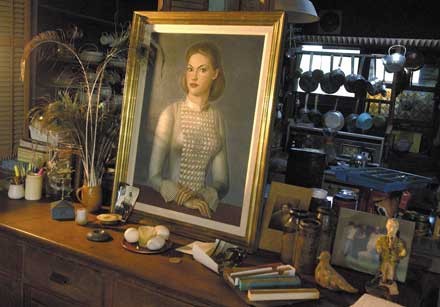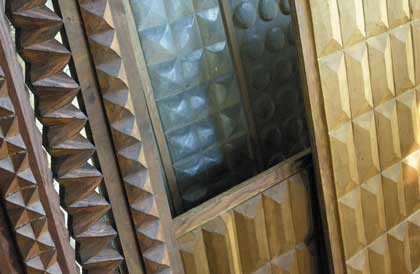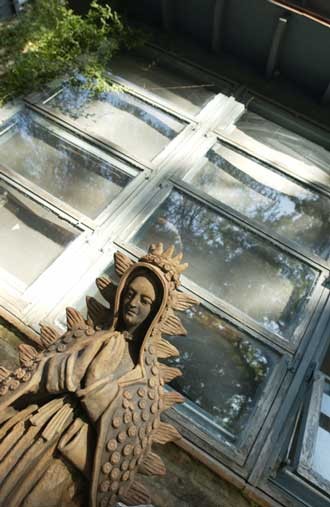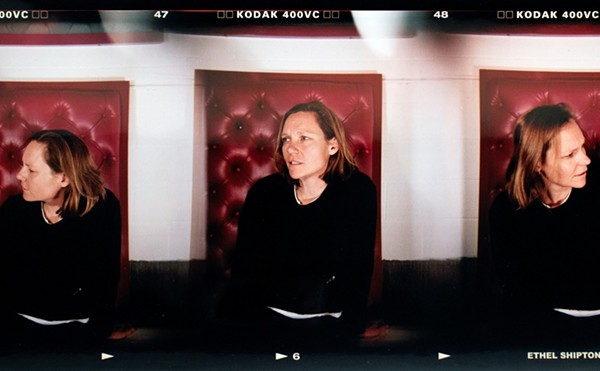Relics of a San Antonio renaissance go on sale next week at O’Neil Ford’s estate
“It’s like Never Land ... ” public-relations pro Nancy Scott Jones says as we walk across the spiraling brick courtyard at Willow Way, the former home of Texas’ most revered architect, O’Neil Ford. Estate-sale director Tomme Lu Riklin completes the thought: “... where you never have to leave or grow up.” A handful of territorial geese honk that, on the contrary, we don’t belong in this fairy tale.
In the 40 years after Maury Maverick Sr. brought him to San Antonio to work on La Villita’s restoration in 1939, Ford designed many of the city’s defining buildings, from La Villita Assembly Hall to much of Trinity University to St. Mary’s Hall to the UTSA 1604 campus. Trinity’s Murchison Tower and the Tower of the Americas are lonely Apollonian sentinels in a career defined by a modest modernism flush with its surroundings. At the height of his popularity, Ford created signature homes for some of the city’s wealthiest and most influential citizens, Southwest Research Institute founder Tom Slick among them, and he became the virtual house architect for the founding partners of Texas Instruments. His firm, Ford, Powell & Carson, founded in 1967, is still one of San Antonio’s most formidable. Ford kept an always-busy office in a King William bungalow, but his home base was Willow Way, where he and his wife, Wanda, raised their four children in a Texas-style artists’ commune.
| A portrait of Wanda Ford by Dallas artist Tom Stell rests on a buffet made by Lynn Ford in the dining room at Willow Way. (Photos by Mark Greenberg) |
Willow Way today is a 10-acre refuge for game hens, peacocks, cantankerous geese, and a stray pit bull whose elongated teats suggest abandonment by an unscrupulous breeder. It is located on the city’s far South Side, next to Rancho del Charro and in the shadow of Mission San Jose, to which it once belonged, well-concealed by a thick stand of bamboo and undistinguished greenery. O’Neil died in 1982, Wanda in 2002, and the workshop where Ford’s brother, Lynn, and Wanda’s mother, Elizabeth Orynski Graham, worked appears abandoned mid-project. Ceramics await glaze on an upper shelf, and Graham’s tools, painted pink and branded “Willow Way,” hang expectantly in her tool locker. One son, Michael, still lives here among a half-dozen structures, rough amalgamations of 19th-century farm buildings and signature Ford additions softened by weathering and vines.
The fowl seem to be the true landlords of this romantic setting, roosting among the remnants of an epic Texas life: pieces of a massive industrial cast-iron staircase, a carnival sign whose empty light sockets advertise Games of Skill, lawn furniture by legendary faux-bois artist Dionicio Rodríguez. A small woodframe house with a hearth that could hold a Mini Cooper is given over entirely to silverfish-infested books inscribed “Willow Way Library” in graceful penmanship, and a trio of doves — heirs, perhaps, of the original residents — are kicking the tires of a well-appointed dovecote.
“`Willow Way` was sort of wonderfully chaotic, but it wasn’t like a junk heap,” recalls architecture critic David Dillon, a friend of Ford’s and author of The Architecture of O’Neil Ford: Celebrating Place. “If you went there you always found these wonderfully interesting things, whether they were books, or bits and scraps of things that O’Neil brought back from Mexico or Peru or wherever he happened to be traveling, so there was kind of this whole life on display there.”
| Among the items for sale at the estate sale are carved-wood and hammered-lead panels by Lynn Ford. |
Along with “All hat, no cattle,” a fatal Texas put-down is “he knows the price of everything, and the value of nothing.” The Fords, on the other hand, seem to have understood the potential value of everything, from shapely Mexican bird cages to petrified dinosaur turds. Riklin’s job is to bring order to this poetic chaos, to sort a mountain of sentimental detritus from Martha Mood ceramics and rare tin Spratling candelabra — lanterns here, strap-on roller skates there, terra-cotta pots in the greenhouse — and price it all according to what the market will bear for a four-day estate sale that begins November 2.
Estate sales are hardly uncommon in San Antonio. They move in waves through historical neighborhoods, following the path of the city’s development; the unit of measurement is lifespans, marked by steamer trunks full of creweled handkerchiefs and velvet opera coats in Monte Vista and Art Deco vanities tagged and unceremoniously plonked on driveways in Monticello.
But this sale is different. Available for a price at Willow Way next weekend will not be mere bric-a-brac and furniture, but one of San Antonio’s golden moments; it’s no less momentous in its way than if the Alamo were on the auction block. “Willow Way represents a state of mind more than anything else,” says Dillon. “It was one of the great gathering places for artists and architects in San Antonio for years.”
Wanda’s mother purchased the former farm in the ’20s, and she remained its grand dame when O’Neil and Wanda began adding to the family tree. O’Neil’s younger brother, Lynn, whose carved geometric panel doors grace Trinity University and other Ford buildings, lived and worked on the property, along with the family from Mexico who bricked the courtyard. “`O’Neil` sort of supported this whole repertory company of craftsmen. There were always people coming and going, showing him stuff,” recalls Dillon. “Some worked for him; some just showed up.”
| The fountain outside the main house embodies Ford’s architectural ideals: simple, modern structures enhanced with regional crafts. |
Ford, Powell & Carson Vice President Carolyn Peterson was one of those people. She and her husband, Jack, began working for Ford straight out of school and moved to Willow Way in 1964. “It was a very creative atmosphere,” says Peterson. “Lynn’s workshop was just across our lawn, and they worked at night all the time. It was so exciting because you’d see the craft developing from a blank piece of wood to a finished carved piece.” O’Neil was influenced strongly by the English Arts and Crafts movement and he also commissioned custom light fixtures from Lynn, some of which can be seen in Trinity’s chapel, and work from artists such as Mood and Dallas painter Tom Stell, who in turn became Willow Way regulars.
At the eye of this creative storm was Ford. “O’Neil loved to be the paterfamilias, not just to his own kids, but he was this kind of person who loved to hold forth all the time,” says Dillon. At Ford’s funeral, another Ford fan and peer, humorist John Henry Faulk, included him in an influential Texas cultural pantheon that valued place and nature, immortalized by the Philosophers Rock sculpture at Austin’s Barton Springs: J. Frank Dobie, Roy Bedicheck, and Walter Prescott Webb.
Riklin says she is not at liberty to discuss her clients’ post-sale plans, but the topic of preservation comes up often in conversations about Willow Way. “I would like to think that San Antonio would preserve it, or whoever buys it, not because it’s some sort of architectural masterpiece — because it’s not — but because of all the things that happened there,” says Dillon.
Dillon’s sentiment probably would not be lost on the Fords, especially as City crews finish resurfacing the road and adding sidewalks to the formerly pastoral Padre Drive that runs past Willow Way’s entry. Wanda and Graham were both leaders in the influential San Antonio Conservation Society, and Ford made preservation a cornerstone of his developments, even when it cost him business. Because of his stubborn opposition in the ’60s and ’70s to the North Expressway development, Ford’s firm never received another city contract while he was alive. His efforts to save the historic homes within the HemisFair ’68 grounds cost him his job as lead architect, although he was allowed to finish the Tower of the Americas.
Across the inviting main yard at Willow Way, where oversize rough-hewn picnic tables still beckon guests, the twin boveda roofs of the small house Ford designed for his sons peak between the trees. Ford introduced bovedas, graceful brick vaulted ceilings, to San Antonio by importing Mexican masons from San Miguel de Allende, where he first saw the technique used. It is yet another example of the way Ford’s life and art were mutually reinforcing and sustaining. Shoppers at the Willow Way estate sale may be tempted to try to separate what seems like wheat from chaff, but that would be a false division.
“I think what’s visible at Willow Way is, on the one hand the incredible range of interests, the kind of magpie quality of the collecting that `Ford` did,” concludes Dillon, “and to some extent the messiness of his life — it was not exactly clean in the traditional sense — there were all kinds of ghosts, all kinds of loose ends, and they’re all out there at Willow Way, too.” •
By Elaine Wolff


















